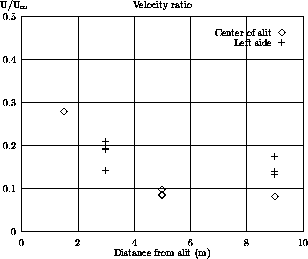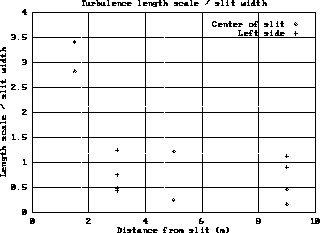



Next: NTT rotating building
Up: Classical domes
Previous: Measuring equipment and
The main results from the measurements are given in the figures
found in the
next pages, as a function of the distance from the edge of the slit.
Some measurements were taken along the center of the slit,
others halfway to the left side, as it was remarked
that flow and turbulence were
often stronger along the sides than along the slit mid-line.
The 3.6-m dome, even with the slit facing the wind, acts as
an efficient wind shield in terms of mean flow velocity.
Nevertheless, the slit is the cause
of velocity fluctuations inside the dome, which are
larger than in the original atmospheric turbulence. This
dome induced turbulence has a mean scale of the order of the slit width
and a peak frequency in the range 0.3 to 1 Hz.
In proximity of the slit this effect causes also
fluctuations of the dynamic pressure term  that are larger than in the free atmosphere, particularly in
the frequency range above 1 Hz where they might directly affect
the tracking behavior of an hypothetic telescope whose top structure
would come closer to the slit than the present telescope.
Further inside the dome, because of the large decrease of mean
velocity the amplitude of pressure fluctuations
is largely below the situation in the free flow.
that are larger than in the free atmosphere, particularly in
the frequency range above 1 Hz where they might directly affect
the tracking behavior of an hypothetic telescope whose top structure
would come closer to the slit than the present telescope.
Further inside the dome, because of the large decrease of mean
velocity the amplitude of pressure fluctuations
is largely below the situation in the free flow.

Figure: Measurement locations in the 3.6-m dome.

Figure: The vortex anemometer placed near the
slit (a) and further inside the dome (b).

Figure: Ratio of mean flow velocity ratio  .
.

Figure: Absolute turbulence intensity
 . The free stream value during the measurements
was about 0.04 .
. The free stream value during the measurements
was about 0.04 .

Figure: Turbulence scale  divided by the slit width (5 m).
The turbulence scale in the free atmosphere at the location and
level of the 3.6-m dome is in the range 50 to 200 meters.
This free flow turbulence is still a contributing factor
close to the edge of the dome (
divided by the slit width (5 m).
The turbulence scale in the free atmosphere at the location and
level of the 3.6-m dome is in the range 50 to 200 meters.
This free flow turbulence is still a contributing factor
close to the edge of the dome ( = 14-17 m); further inside we
have purely slit made turbulence.
= 14-17 m); further inside we
have purely slit made turbulence.

Figure: Normalized gust
spectra at different locations inside the dome and, for
reference, in the free flow.
In the free atmosphere most of the wind
turbulence energy is found in the range 0.01 to 0.05 Hz. In the
dome a peak in the range
0.3 to 1 Hz appears, which takes more of the turbulent energy the
further away one is from the slit. Note that the spectra are here
normalized with the respective  values.
values.




Next: NTT rotating building
Up: Classical domes
Previous: Measuring equipment and
Lorenzo Zago, lorenzo.zago@heig-vd.ch,
Mon Nov 6 23:33:14 GMT+0100 1995
 that are larger than in the free atmosphere, particularly in
the frequency range above 1 Hz where they might directly affect
the tracking behavior of an hypothetic telescope whose top structure
would come closer to the slit than the present telescope.
Further inside the dome, because of the large decrease of mean
velocity the amplitude of pressure fluctuations
is largely below the situation in the free flow.
that are larger than in the free atmosphere, particularly in
the frequency range above 1 Hz where they might directly affect
the tracking behavior of an hypothetic telescope whose top structure
would come closer to the slit than the present telescope.
Further inside the dome, because of the large decrease of mean
velocity the amplitude of pressure fluctuations
is largely below the situation in the free flow.







 .
.
 . The free stream value during the measurements
was about 0.04 .
. The free stream value during the measurements
was about 0.04 .
 divided by the slit width (5 m).
The turbulence scale in the free atmosphere at the location and
level of the 3.6-m dome is in the range 50 to 200 meters.
This free flow turbulence is still a contributing factor
close to the edge of the dome (
divided by the slit width (5 m).
The turbulence scale in the free atmosphere at the location and
level of the 3.6-m dome is in the range 50 to 200 meters.
This free flow turbulence is still a contributing factor
close to the edge of the dome ( = 14-17 m); further inside we
have purely slit made turbulence.
= 14-17 m); further inside we
have purely slit made turbulence.
 values.
values.